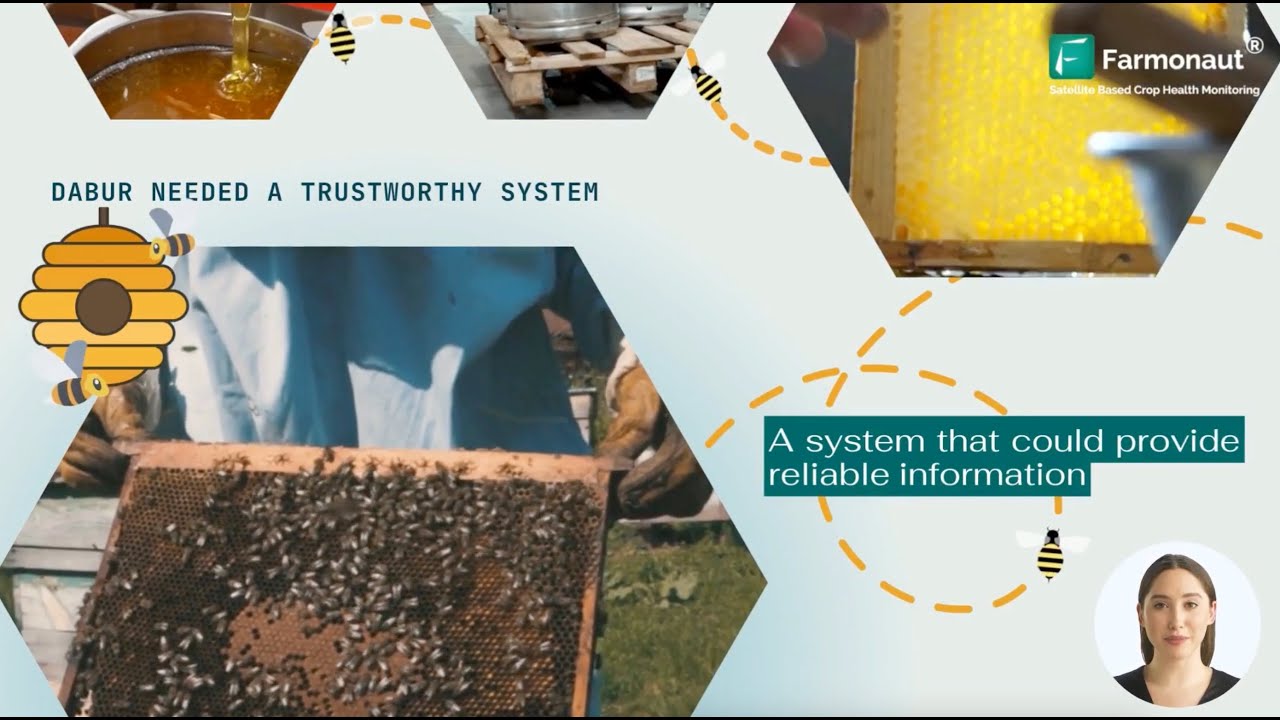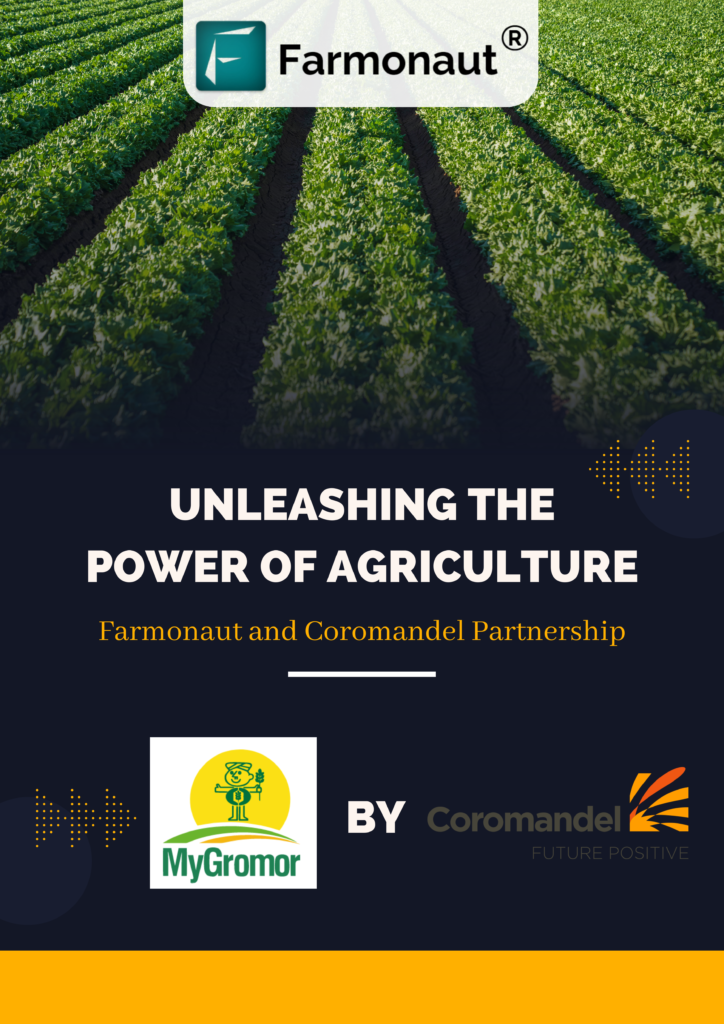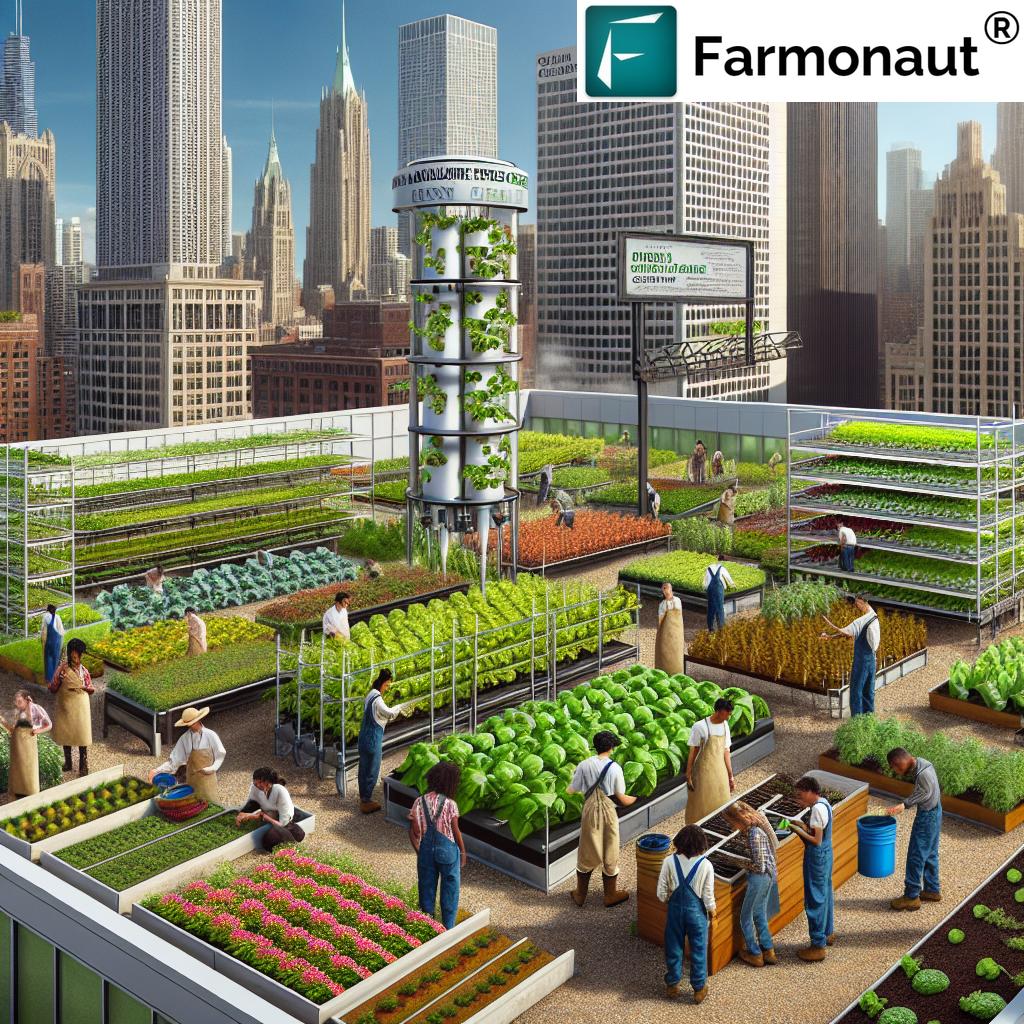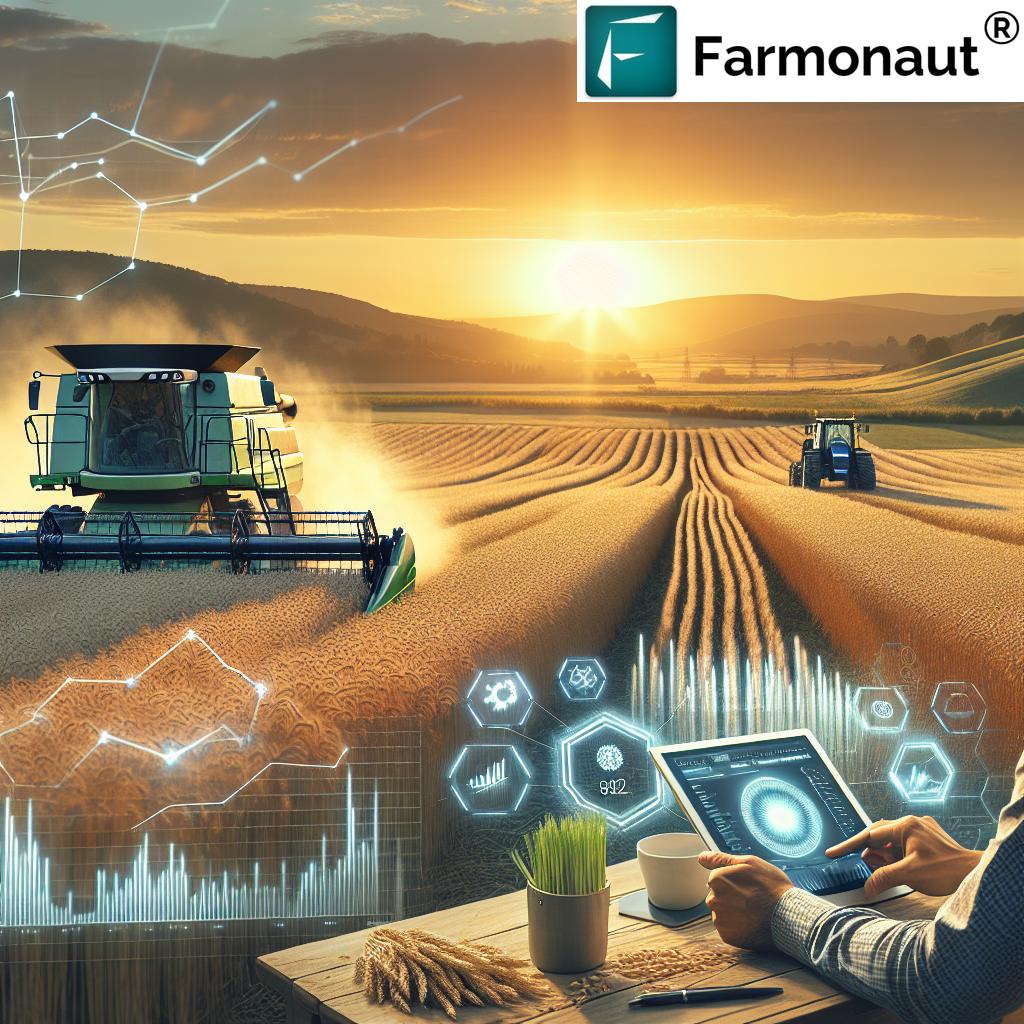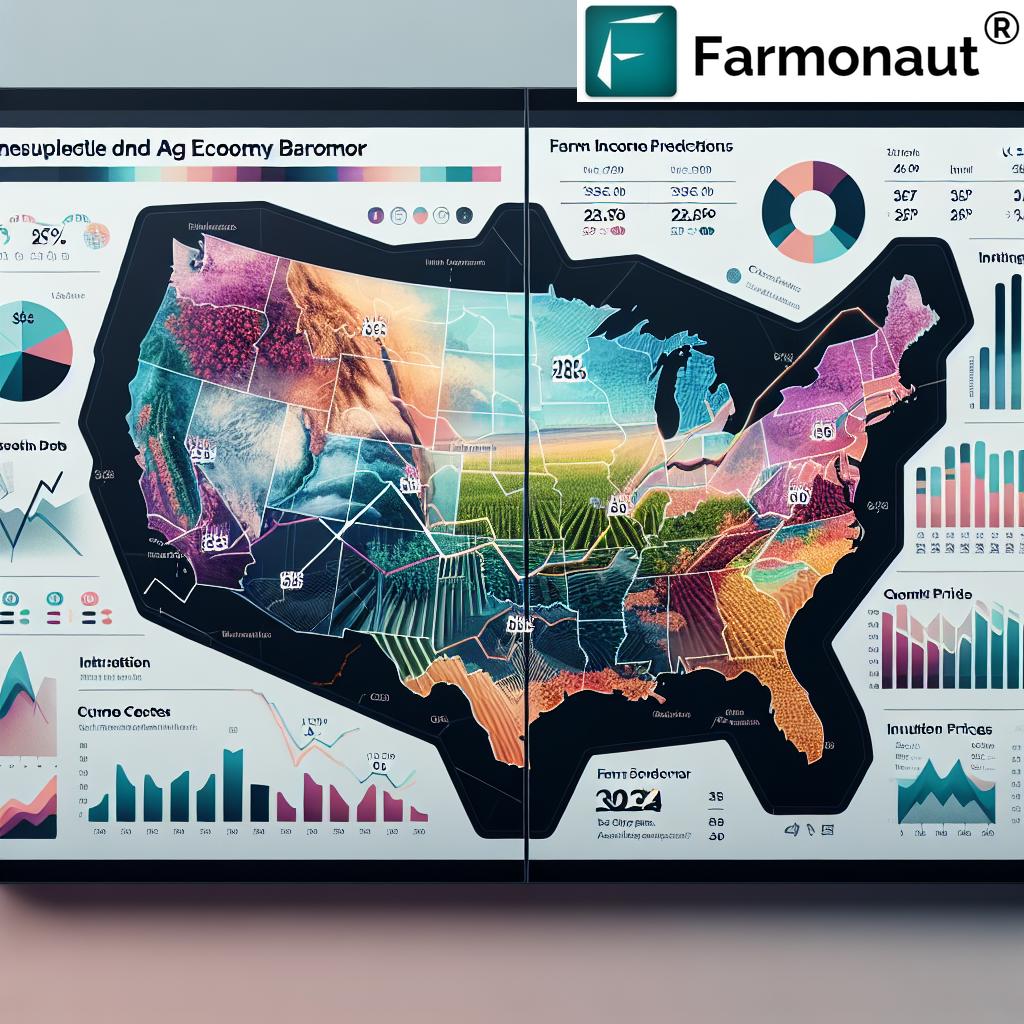Agriculture Technology in Food: 7 Shocking New Breakthroughs
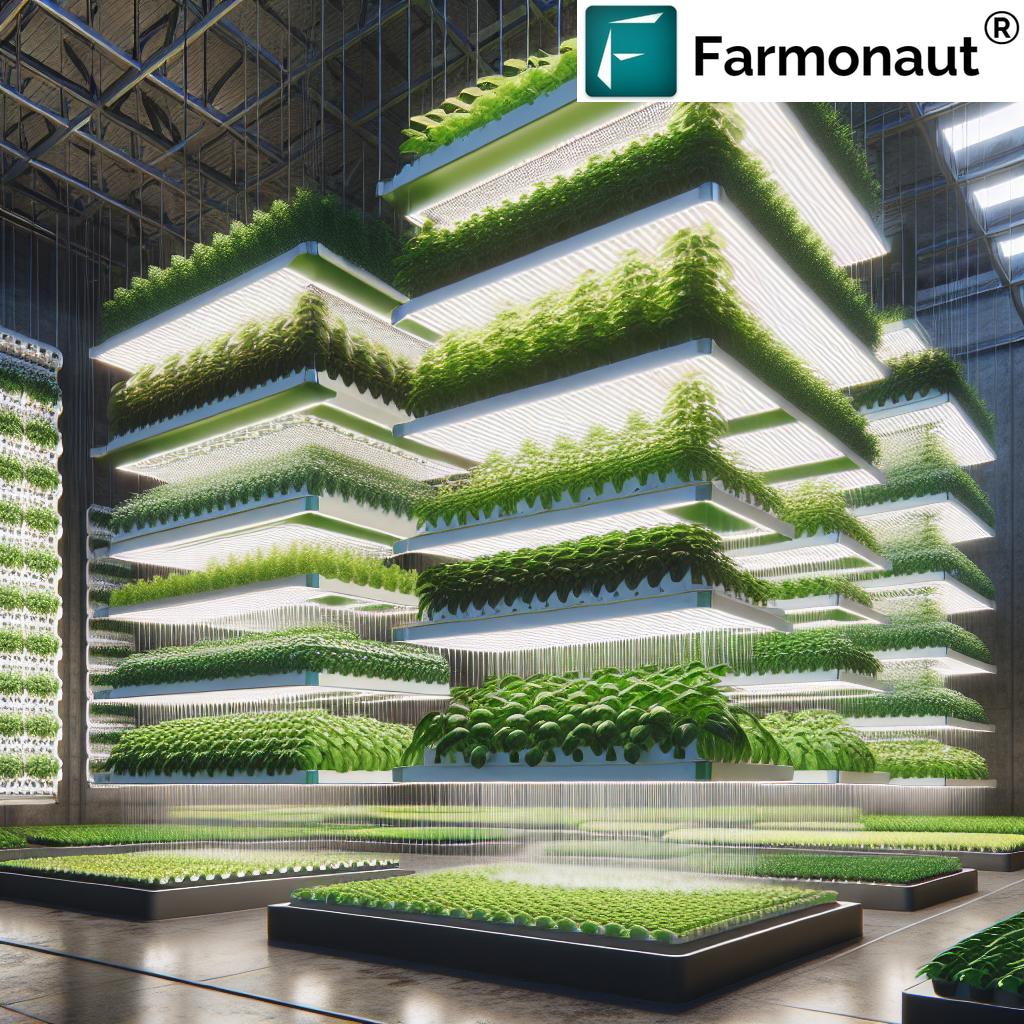
- Access Farmonaut’s Satellite & Weather API for seamless integration of agricultural data into your own systems. Explore Developer Docs to enhance your applications with real-time crop health data and analytics.
Introduction: Revolutionizing Agriculture with Innovative Technology
The realm of agricultural technology is experiencing a remarkable transformation. As global populations surge and climate unpredictability challenges our traditional methods, the race for sustainability, efficiency, and food security has never been more intense. From bustling urban landscapes to remote fields, the emergence of innovative farming technologies such as vertical farming, controlled environment agriculture (CEA), and the integration of blockchain traceability are redrawing the map of food production.
In this comprehensive exploration, we’ll dive into seven shocking agricultural breakthroughs disrupting the food industry. By harnessing resource efficient agriculture and leveraging tools such as Farmonaut’s Carbon Footprinting and Blockchain Product Traceability solutions, we are witnessing a new era—one where data-driven decisions, circular systems, and eco-friendly innovation take center stage.
Controlled-Environment Agriculture (CEA): Boosting Efficiency and Sustainability
Controlled environment agriculture (CEA) is revolutionizing crop cultivation by allowing us to regulate variables—temperature, humidity, light, and CO₂ levels—that were once left to chance. CEA includes greenhouses, high-tech plant factories, and vertically stacked farms. Through advanced technological systems, we achieve:
- Year-round production and consistently high yields
- Resource optimization, often using up to 95% less water than traditional open fields
- Reduction in dependency on unfavorable weather conditions
- Increased plant growth rates and more predictable harvesting
- Greater control over nutrient delivery and pest management
In the quest for resource efficient agriculture, CEA empowers us to minimize wastage, enhance urban food production, and strengthen the global food supply chain.
The adoption of CEA is spreading rapidly across regions with extreme climates and urban density. It allows us to produce fresh, local food even in places with limited arable land and challenging external weather conditions. For farmers utilizing Farmonaut’s satellite-based crop health monitoring, combining real-time insights with CEA’s precision unlocks maximum productivity and sustainability.
Vertical Farming: The Urban Production Powerhouse
At the heart of urban agricultural innovation lies vertical farming—a subset of CEA. By stacking layers of crops in controlled environments, this method leverages upward space, not outward expansion, preserving precious arable land.
- Vertically stacked layers in indoor environments (e.g., warehouses, skyscrapers)
- Integration with hydroponic and aeroponic systems for optimal plant growth
- Precision waste management and nutrient recycling
- Reduced transportation costs for hyper-local, fresh produce
- Contributes greatly to urban food production and self-sufficiency
With vertical farming, we maximize every cubic meter, achieving 8–10 times the yield of traditional farms per acre, while dramatically reducing land use, water consumption, and chemical fertilizers. These farms are a beacon for sustainable agriculture methods in our growing cities.
Vertical farming not only boosts resource efficient agriculture but also ensures resilient food production in the face of climate uncertainty. By feeding growing urban populations, it closes the gap between farms and tables, slashing environmental impacts from transportation.
Aeroponics Technology: Next-Level Plant Cultivation
Imagine a technique where plant roots never touch soil or water reservoirs. Aeroponics technology suspends crops’ roots in the open air and nourishes them with a fine misted nutrient solution.
- Roots suspended in air for maximum oxygen exposure and nutrient uptake
- Extremely low water use with near-total recycling of inputs
- Supports rapid growth and minimizes disease risks
- Highly controlled environment for regulating variables such as temperature and light
Organizations such as NASA have extensively researched aeroponics for sustainable food production on space missions. Nowadays, aeroponic systems are empowering urban farmers, boosting resource efficiency and yield in compact settings.
By using aeroponics in combination with large-scale farm management tools, both smallholders and commercial producers can monitor growth data, adjust environmental parameters, and tailor nutrient delivery for unmatched productivity and sustainability.

Aquaponics Systems: Harmony of Fish and Plants
Aquaponics systems are a masterclass in symbiosis, combining aquaculture (raising fish) with hydroponic farming (growing plants without soil) within a closed loop.
- Fish waste provides organic nutrients for plants
- Plants filter and purify the water, creating a self-sustaining cycle
- Exceptional water conservation—up to 90% less than traditional systems
- Minimizes or eliminates need for synthetic chemical fertilizers
These systems optimize resource use (Fleet management tools further streamline operational logistics), contribute to lowering environmental impact, and are ideal for urban food production where space and resources are scarce. With integrated control of temperature, humidity, and light, aquaponics systems provide resilience against external weather conditions.
Aquaponics enables us to cultivate fresh vegetables, herbs, and even fish in settings as varied as schools, rooftops, or city warehouses—demonstrating the flexible power of innovative farming technologies.
3D Food Printing: Personalized and Sustainable Nutrition
3D food printing is ushering in a future where nutrition can be personalized and produced with minimal waste. This technology involves creating edible products layer by layer from food-grade ingredients, offering:
- Customization for individual dietary needs
- Creation of intricate, visually appealing shapes and textures
- Reducing food waste by using unconventional or surplus ingredients
- Facilitating the consumption of sustainable protein sources like insect or plant proteins
By leveraging 3D printing, we open doors to sustainable culinary creativity. Universities and food tech startups are exploring the potential for hospitals, elderly care, and disaster relief—anywhere nutrition must meet strict and variable criteria.
As the commercialization of such products continues, it’s easy to imagine a future where personalized, nutrient-optimized meals can be “printed” on demand, reducing the environmental impact of traditional food production.
Blockchain Traceability in Agriculture: Food Safety and Trust
The food industry is rapidly embracing blockchain traceability in agriculture to bolster food safety, transparency, and consumer trust. Blockchain’s decentralized, immutable ledger records every transaction and event in the food supply chain — from seed to shelf.
- True traceability for crops and products
- Reducing fraud and ensuring authenticity (e.g., organic, fair trade, or non-GMO claims)
- Enabling real-time verification for food recalls and contamination prevention
- Empowering consumers to look up the exact journey of their food
Farmonaut’s Blockchain Product Traceability solution takes this a step further by providing secure, verifiable data for every stage of agricultural production. This greatly benefits distributors, corporate clients, and end-consumers alike, while supporting compliance with regulatory standards.
As global supply chains grow more complex, blockchain traceability in agriculture is not just a trend, but a necessity for safe and sustainable food production.
Lab-Grown Meat: The Future of Protein
The conversation about sustainable agriculture methods is incomplete without addressing protein. Lab-grown meat—also called cultured meat—is produced by cultivating animal cells in controlled environments. Here’s how this game-changing innovation is reshaping food production:
- Eliminates the need for traditional animal farming
- Significantly reduces land use, water consumption, and greenhouse gas emissions
- Provides the same taste and texture as conventional meats
- Facilitates ethical and cruelty-free consumption
- Accelerates commercialization in regions with high demand for meat but limited arable land
In 2023, the approval of cultivated chicken for sale in the U.S. marked a major step forward, hinting at a future where we meet growing protein appetites without straining the planet’s resources. Lab-grown meat aligns perfectly with both consumer demand and environmental priorities.
Comparison Table of 7 Groundbreaking Agricultural Technologies
| Technology Name | Brief Description | Key Innovative Feature | Resource Efficiency Gain | Urban Food Production Potential | Sustainability Impact |
|---|---|---|---|---|---|
| Vertical Farming | Stacking crops vertically in controlled indoor environments | Maximizes yield in urban settings with minimal land | Up to 95% less water, 200–500% yield increase/acre | High — ideal for metropolitan cities and brownfields | Reduces CO₂ & input use by 50–90% |
| Controlled-Environment Agriculture (CEA) | Cultivating crops in highly managed settings | Full control of temperature, humidity, & CO₂ levels | Up to 95% water savings | Flexible — adaptable to urban and rural sites | Napless waste, energy-efficient, pesticide reduction |
| Aeroponics | Suspending plant roots in misted air chambers | Highest oxygen and nutrient delivery | Up to 98% less water | Medium/High — small-footprint, modular designs | Minimal environmental footprint, reduced fertilizers |
| Aquaponics | Integrates fish farming and hydroponics | Closed-loop nutrient cycling | Up to 90% water reduction, no chemical fertilizers | Medium — rooftops, local farms, classrooms | Zero waste, organic outputs, reduced pollution |
| 3D Food Printing | Using printers for customized, edible designs | Personalized nutrition & waste minimization | Transforming surplus & alternative proteins | Emerging — potential for urban/convenience foods | Reduces food waste, lower environmental impact |
| Blockchain Traceability | Decentralized ledger for secure food tracking | Transparency from farm to table | Eliminates fraud, enhances efficiency | All scales — boosts confidence in urban products | Supports ethical, low-carbon supply chains |
| Lab-Grown Meat | Cultivating animal protein without livestock | Direct cell-based production | 80–95% less land & water required | Significant — scalable for dense populations | Up to 96% less GHG emissions, no antibiotics |
Impact on Food Security and Sustainability
The integration of these agricultural technologies fundamentally addresses three pressing challenges:
- Resource Efficiency: Techniques such as vertical farming and aquaponics systems are making major strides in reducing water and land use. These approaches optimize resources for maximum output with minimal footprint.
- Sustainability: Lab-grown meat and 3D food printing could slash greenhouse gases and dramatically cut waste, ensuring environmentally sustainable production for coming generations.
- Food Security: CEA and blockchain traceability in agriculture provide steady food supplies and transparent safety standards, vital for a resilient and trustworthy global supply system.
We must highlight how these innovative farming technologies also offer solutions for rapidly urbanizing countries or those with climate-induced food insecurity. Together, they create a solid foundation for smarter, safer, and more equitable food systems.
Interested in farm sustainability and carbon footprint tracking? Learn about Farmonaut’s Carbon Footprinting services—empowering agribusinesses with actionable environmental impact data.
Challenges and Considerations
While we celebrate unprecedented advancements, the journey towards universal adoption is not without challenges:
- High Initial Costs: Advanced technologies like vertical farms and blockchain systems require significant investment, possibly deterring smaller growers.
- Technological Accessibility: There is a risk of widening global food insecurity if developing regions lag behind in adopting innovative methods.
- Regulatory Hurdles: The commercialization of lab-grown meat and novel food products faces regulatory and consumer approval barriers.
- Cultural Acceptance: The public’s trust in genetically engineered food, 3D printed meals, or cell-based protein varies across countries and generations.
- Operational Complexity: Integrating and maintaining highly automated systems requires expertise in data science, biology, engineering, and logistics.
In addition, ensuring that sustainable progress is made globally, not just in high-tech or wealthy regions, demands equity-focused policies and knowledge transfer.
To help bridge these gaps, Farmonaut offers satellite-based crop verification for insurance and loans, making it easier for individual farmers and agribusinesses to access financing and invest in resource efficient agriculture.
Farmonaut’s Advanced Agricultural Solutions
Farmonaut is at the forefront of the agricultural technology revolution, delivering a powerful platform for precision farming that’s both accessible and scalable globally. Let’s examine how Farmonaut’s solutions contribute uniquely to this ecosystem:
- Satellite-Based Crop Health Monitoring: By leveraging multispectral satellite images, Farmonaut provides real-time analysis of crop health, soil moisture, and vegetative growth. This empowers us to reduce waste, cut unnecessary input costs, and optimize plant growth for both urban and rural farms.
- AI-Driven Farm Advisory (Jeevn AI): The Jeevn AI Advisory System delivers customized, real-time guidance on irrigation, fertilization, and pest management. Farmers receive actionable insights that directly improve yields and resource utilization.
- Blockchain-Based Product Traceability: With a transparent, immutable record of every stage in the production process, Farmonaut’s solution ensures traceability, supporting safe and ethical supply chains. This boosts both regulatory compliance and consumer confidence in agricultural products.
- Fleet and Resource Management: Efficient fleet management helps agribusinesses monitor vehicles and equipment, optimize fuel, and improve delivery safety—all vital for large-scale farms and urban food production.
- Carbon Footprinting & Sustainability Tracking: With carbon emissions monitoring, Farmonaut provides the data businesses need to prove environmental stewardship and make evidence-based changes for sustainable agriculture methods.
- Product Traceability for Corporate Clients: Food and textile brands enhance their reputation and unlock new value by assuring customers of transparency via Blockchain-verified transparency.
Whether you are a smallholder seeking step-by-step crop guidance or an enterprise optimizing vast agricultural resources, Farmonaut’s blend of satellite, AI, and blockchain helps achieve higher efficiency, safety, and sustainability at every level.
- Interested in scaling your agri-business? Explore large-scale farm management solutions designed for plantations, NHOs, and government bodies.
- Want to verify and track sustainable sourcing? See how Farmonaut’s traceability can transform supply chain transparency for your brand.
Farmonaut Subscription Plans
For flexible, scalable access to advanced satellite imagery and analytics, select your Farmonaut subscription package below:
FAQs: Agriculture Technology and the Future of Food
What is the difference between vertical farming and controlled environment agriculture?
Vertical farming is a specialized form of controlled environment agriculture (CEA) where crops are grown in stacked vertical layers—usually indoors—with precise control over variables like temperature, humidity, and light. While CEA also includes greenhouses and horizontal plant factories, vertical farming maximizes yield per area and is ideal for urban settings with constrained land.
How do aquaponics systems optimize resource use?
Aquaponics systems integrate aquaculture and hydroponic farming to create a closed-loop cycle—fish waste supplies nutrients to plants, which in turn clean the water for fish. This minimizes external fertilizer input, reduces water usage, and provides both plants and fish as food products.
How does blockchain traceability improve food safety in agriculture?
Blockchain traceability in agriculture establishes an indelible record for every step of the supply chain. By ensuring transparency from farm to table, it reduces fraud, speeds up recalls, builds consumer trust, and promotes compliance with regulatory standards.
Can small-scale farmers benefit from these technologies?
Absolutely. Platforms like Farmonaut make advanced precision agriculture accessible, allowing individual farmers to use satellite imagery, AI, and resource management tools without heavy upfront investment. This democratizes access and drives efficient, data-driven decisions on every farm.
What is the environmental impact of lab-grown meat?
Lab-grown meat reduces land and water use by up to 95% and cuts greenhouse gas emissions by nearly 96% compared to traditional animal farming. It also removes the need for antibiotics and offers an ethical, sustainable protein source.
How does Farmonaut support sustainable agricultural practices?
Farmonaut promotes sustainability through carbon footprint tracking, remote crop health monitoring, blockchain-based traceability, and efficient fleet/resource management. Its solutions drive responsible use of inputs, optimize yields, and reduce waste throughout the production cycle.
Conclusion
Agriculture technology is boldly reshaping the future of food. As innovations like vertical farming, controlled environment agriculture, aeroponics technology, aquaponics systems, 3D food printing, blockchain traceability in agriculture, and lab-grown meat take hold, we are forging new paths toward sustainability, efficiency, and food security.
Still, to harness the full promise of these technologies, we must address challenges around cost, equity, access, and regulatory frameworks—ensuring no one is left behind. By embracing modern systems, informed by real-time data and a commitment to transparency, we are empowering every farmer, business, and consumer to become a stakeholder in a resilient, healthy, and sustainable food system.
Explore Farmonaut’s solutions today—whether it’s leveraging Carbon Footprinting, tracking Blockchain Product Traceability, managing Crop Loans & Insurance, or enhancing large-scale farm management. Join the revolution today for a sustainable tomorrow.
The future of agriculture is data-driven, resilient, and sustainable—be part of it with innovative technologies that transform food for the better.








